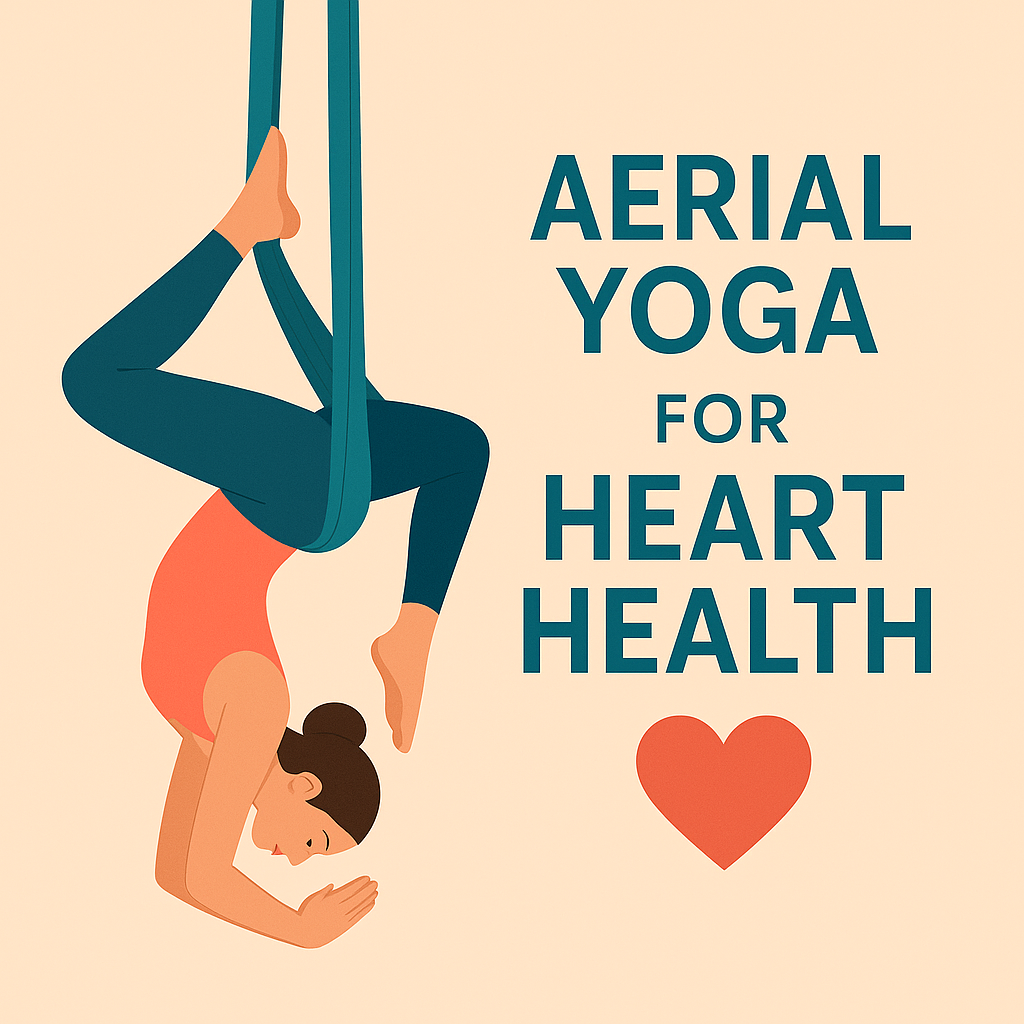How to Start Yoga for Beginners with The Pink Lotus Academia
Heart health is becoming more important than ever. With long sitting hours, rising stress levels, irregular sleep, and emotional pressure, cardiovascular issues affect people of all ages today. Many experts now recommend aerial yoga for heart health, as it blends yoga movement, inversion therapy, breath control, and relaxation to support the heart naturally.
Aerial yoga works with a hammock or suspension silk that supports the body during yoga postures. This style reduces pressure on joints, improves posture, supports deep breathing, and calms the nervous system—key components needed for a healthy heart.
Let’s explore why aerial yoga is so powerful for the heart and how it can change your health.
What Is Aerial Yoga? A Simple Explanation
Aerial yoga is a form of yoga where a soft hammock supports your body weight during poses. You’re not floating in the air all the time—most poses are done close to the ground with partial weight support.
Aerial Yoga Combines:
-
Traditional yoga postures
-
Suspension training
-
Breathwork
-
Gentle inversions
-
Mind–body relaxation
It’s especially helpful for people who find regular yoga challenging due to stiffness, back pain, or low stamina—all of which indirectly affect heart health.
Understanding Heart Health in Today’s Lifestyle
Modern routines affect heart health in several ways:
-
High stress elevates cortisol
-
Sedentary work reduces circulation
-
Poor sleep affects heart rhythm
-
Irregular meals disturb blood pressure
-
Anxiety affects breathing patterns
Aerial yoga helps counter these issues directly by improving breathing, posture, flexibility, muscle strength, and mental clarity.
Why Aerial Yoga Is Powerful for Your Heart
Aerial yoga uniquely benefits the cardiovascular system because:
-
The hammock supports your body, reducing pressure on the spine and allowing deeper breathing.
-
Inversions promote blood flow from the lower body back to the heart.
-
Floating movement relaxes the nervous system faster than floor yoga.
-
Backbends are easier with support, improving chest expansion and oxygen flow.
Together, these create the ideal environment for a happier, stronger heart.
17 Major Benefits of Aerial Yoga for Heart Health
Below are the most important benefits explained clearly and simply.
1. Improves Circulation
Suspended movement encourages natural blood flow to the upper body.
2. Enhances Oxygen Flow
Chest-opening postures become easier with hammock support.
3. Reduces Stress Hormones
Floating movement reduces cortisol, the enemy of heart health.
4. Lowers Blood Pressure
Deep breathing and inversions help stabilize blood pressure naturally.
5. Strengthens Core & Heart-Supporting Muscles
Core muscles support posture and reduce strain on the heart.
6. Boosts Heart Rate Variability
HRV indicates how well your heart adapts to stress.
7. Improves Respiratory Function
The hammock supports longer, deeper breathing patterns.
8. Enhances Emotional Well-being
Gentle floating movements create a sense of safety and peace.
9. Supports Healthy Weight
Aerial yoga burns calories without high-impact movement.
10. Reduces Anxiety & Panic Responses
Perfect for people who experience emotional stress affecting the heart.
11. Improves Blood Flow to the Brain
Mild inversions promote healthy brain–heart coordination.
12. Helps Balance the Nervous System
Supports vagus nerve activation—key for heart rhythm and calmness.
13. Encourages Deep Relaxation
Suspended savasana boosts parasympathetic activity.
14. Enhances Flexibility for Better Heart Function
Stiffness limits breathing and strains the heart—flexibility reduces this.
15. Improves Posture for Better Cardiac Health
Good posture opens the chest, reducing pressure on the heart.
16. Assists in Heart Rehabilitation (with doctor approval)
Gentle aerial movement can support recovery.
17. Strengthens the Mind–Body Connection
Better awareness helps people adopt a heart-healthy lifestyle.
Best Aerial Yoga Poses for Heart Health
Aerial Supported Backbend
Deep chest opener with minimum strain.
Aerial Floating Savasana
Ultimate pose for emotional release and heart relaxation.
Aerial Cat–Cow Flow
Promotes healthy heart rhythm and spinal flexibility.
Aerial Low Lunge Heart Opener
Stretches chest, shoulders, and improves breathing capacity.
Inverted Butterfly (Low Hammock Version)
Gentle inversion for improved circulation.
Scientific Explanation: How Aerial Yoga Helps the Heart
Aerial yoga promotes cardio-respiratory efficiency by:
-
Increasing thoracic mobility
-
Enhancing lung capacity
-
Activating the parasympathetic nervous system
-
Optimizing blood return to the heart
(Reference: American Heart Association – https://www.heart.org/)
Aerial Yoga vs. Traditional Yoga for Heart Health
| Feature | Traditional Yoga | Aerial Yoga |
|---|---|---|
| Support | Full body weight | Partial Body Weight |
| Backbends | Harder | Easier & safer |
| Inversions | Limited | Accessible for beginners |
| Stress Relief | High | Very high |
| Chest Expansion | Moderate | Enhanced |
Safety Tips for Heart Patients
-
Avoid deep inversions unless approved
-
Move slowly
-
Focus on breathwork
-
Stop if dizzy
-
Be guided by a certified instructor
Who Should Avoid Aerial Yoga?
-
People with uncontrolled blood pressure
-
Recent surgery
-
Severe vertigo
-
Glaucoma
-
Pregnancy (inversions only)
-
Severe spine issues
How Often Should You Practice?
3–4 sessions per week with a certified instructor is ideal.
Lifestyle Tips to Support a Healthy Heart
-
Walk 8,000 steps daily
-
Limit processed sugar
-
Reduce smoking & alcohol
-
Practice mindfulness
-
Prioritize sleep
FAQs
1. Is aerial yoga safe for heart health?
Yes, when practiced with guidance, it’s one of the safest forms of yoga.
2. Can beginners try aerial yoga?
Absolutely, the hammock supports your body weight.
3. Does aerial yoga reduce blood pressure?
It can help stabilize blood pressure through breathwork and relaxation.
4. Which aerial pose is best for the heart?
Supported backbends and floating savasana are excellent.
5. Can aerial yoga replace cardio?
It supports heart function but shouldn’t replace walking or moderate cardio.
6. Is aerial yoga good for stress?
Yes, it’s one of the most calming practices for the nervous system.
Conclusion
Aerial yoga isn’t just fun—it’s a powerful heart-health practice. By blending breathwork, posture improvement, inversions, and deep relaxation, it helps improve circulation, reduce stress, strengthen muscles, and support long-term cardiovascular wellness. Practiced safely with a certified instructor, aerial yoga can transform your physical and emotional health.
Learn More: Contact Us
Social: Instagram













